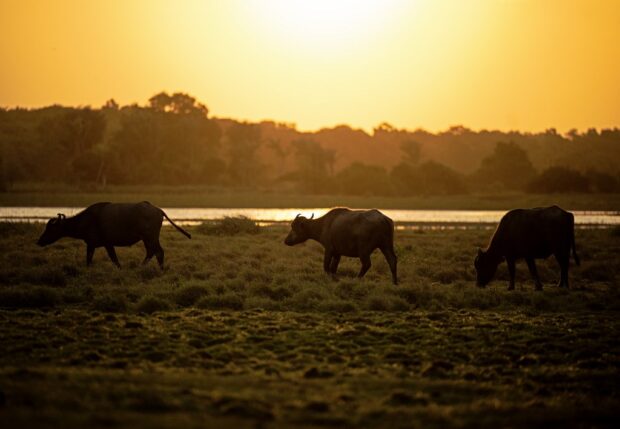On Brazilian island, Asian buffalo claims its place

Asian buffalos roam on farmland during sunset in Soure, Marajó Island, Para State, on September 4, 2023. The Police force has adopted the buffalos as means of transportation to cross waterlogged areas when needed for operations on the island. The buffalos hooves allow them to move easily through muddy swamps and they cope well with the Island’s intense tropical heat. The force was nicknamed Buffalo Soldiers by a Brazilian Magazine in reference to Bob Marley’s hit song “Buffalo Soldier.” (Photo by Carl DE SOUZA / AFP)
SOURE, BRAZIL — An incongruous sight meets visitors to the northern Brazilian island of Marajo: thousands and thousands of water buffalo, animals endemic to India and Southeast Asia that have found a new home in South America.
Some say they arrived on the island from a ship that sank off the coast, others that prisoners who escaped from French Guiana used them to navigate the mangroves to get to Brazil.
While their origins remain a mystery, the Asian water buffalo have taken to Marajo’s tropical climate, where they live in a happy symbiosis with humans on the island bathed by rivers on one side and the Atlantic Ocean on the other.
They number about half a million today—more than the island’s human population of 440,000.
Excellent swimmers, water buffalo can grow up to 1,200 kilograms and 2.5 meters (8.2 feet) nose to tail, and are a popular work animal on Marajo, dragging carriages through the streets of the town of Soure and helping farmers in the fields.
Article continues after this advertisementThe beast is revered in local culture, appearing with its curved horns on product logos and reproduced in sculptures and murals. Local festivals feature buffalo races.
Article continues after this advertisementThe animal is also ubiquitous on restaurant menus, where fat, juicy buffalo steaks are served topped with buffalo mozzarella.
Extraordinarily, the buffalo are also employed as patrol animals by the military police in Soure, where heavily armed officers ride on their backs.
The Soure military police unit’s headquarters is adorned with a plaque made of bullet casings depicting a muscular buffalo holding a shotgun.
“The buffalo patrols arose from the need to send our officers into the flooded fields of Marajo. Thirty years ago that was the only way,” battalion commander Leomar Aviz told Agence France-Presse (AFP).
Thus were born the so-called “Buffalo Soldiers” of Marajo—a nod to the 19th century US army regiments composed mainly of people of African origins, and lionized by reggae star Bob Marley a century later. —AFP
READ: ‘Drunk’ buffalos lead to arrest of farmers illegally selling alcohol